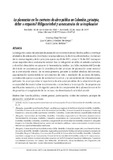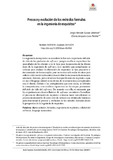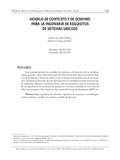Mostrar el registro sencillo del ítem
Non-Functional Requirements Tendering Based on Knowledge Management: the Merlinn Framework
Elicitação de requisitos não funcionais baseada na gestão de conhecimento: o referencial de trabalho Merlinn;
Elicitación de requisitos no funcionales basada en la gestión de conocimiento: el marco de trabajo Merlinn
| dc.contributor.author | Buitrón Ruiz, Sandra Lorena | |
| dc.contributor.author | Flores Rios, Brenda Leticia | |
| dc.contributor.author | Pino Correa, Francisco Jose | |
| dc.date.accessioned | 2019-11-07T15:00:32Z | |
| dc.date.available | 2019-11-07T15:00:32Z | |
| dc.date.created | 2018-07-04 | |
| dc.identifier.issn | 1692-3324 | |
| dc.identifier.uri | http://hdl.handle.net/11407/5502 | |
| dc.description.abstract | Requirements solicitation is considered the basis for the next stages of software development, and involves, among others, collecting and analyzing functional and non-functional requirements (FNR). The literature shows that: (i) there is a lack of NFR elicitation mechanisms and (ii) there is a lack of awareness of NFR by stakeholders. In this sense, this article presents the framework for the tendering of non-functional requirements based on knowledge management (called Merlinn) that seeks the visualization of NFRs and the active participation of stakeholders. Merlinn’s evaluation was conducted through a study case in a software development company. The results of the evaluation show that Merlinn can be ideal and adaptable to support the organization’s NRF tendering process, so that it impacts the quality of the software product. | eng |
| dc.description.abstract | A elicitação de requisitos é considerada a base para as etapas seguintes do desenvolvimento do software e envolve, entre outras, recopilar e analisar requisitos funcionais e não funcionais (RNF). Por meio da literatura, evidencia-se que (i) há falta de mecanismos de elicitação de RNF e (ii) existe um desconhecimento de RNF pelos interessados. Nesse sentido, este artigo apresenta o referencial de trabalho para a elicitação de RNF baseada na gestão de conhecimento (denominado Merlinn), que busca a visualização dos RNF e uma participação ativa dos interessados. A avaliação de Merlinn foi realizada mediante um estudo de caso numa empresa que desenvolve software. Os resultados da avaliação mostram que Merlinn pode ser idôneo e adaptável para apoiar o processo de elicitação de RNF da organização, de maneira que impacta na qualidade do produto software. | por |
| dc.description.abstract | La elicitación de requisitos se considera la base para las etapas siguientes del desarrollo del software, e involucra, entre otras, recopilar y analizar requisitos funcionales y no funcionales (RNF). A través de la literatura se evidencia que: (i) hay falta de mecanismos de elicitación de RNF y, (ii) existe un desconocimiento de RNF por los interesados. En este sentido, este artículo presenta el marco de trabajo para la elicitación de requisitos no funcionales basada en la gestión de conocimiento (denominado Merlinn) que busca la visualización de los RNF y una participación activa de los interesados. La evaluación de Merlinn se realizó mediante un estudio de caso en una empresa desarrolladora de software. Los resultados de la evaluación muestran que Merlinn puede ser idóneo y adaptable para apoyar el proceso de elicitación de RNF de la organización, de manera que impacta en la calidad del producto software. | spa |
| dc.format.extent | p. 155-182 | spa |
| dc.format.medium | Electrónico | spa |
| dc.format.mimetype | application/pdf | |
| dc.language.iso | spa | |
| dc.publisher | Universidad de Medellín | spa |
| dc.relation.uri | https://revistas.udem.edu.co/index.php/ingenierias/article/view/2068 | |
| dc.rights.uri | http://creativecommons.org/licenses/by-nc-sa/4.0/ | * |
| dc.source | Revista Ingenierías Universidad de Medellín; Vol. 17 Núm. 32 (2018): Enero-Junio; 155-182 | spa |
| dc.subject | Requirements engineering | eng |
| dc.subject | Requirements tendering | eng |
| dc.subject | Knowled-ge management | eng |
| dc.subject | Non-functional requirements | eng |
| dc.subject | Case study | eng |
| dc.subject | Engenharia de requisitos | por |
| dc.subject | Elicitação de requisitos | por |
| dc.subject | Gestão de conhecimento | por |
| dc.subject | Requisitos não funcionais | por |
| dc.subject | Estudo de caso | por |
| dc.subject | Ingeniería de requisitos | spa |
| dc.subject | Elicitación de requisitos | spa |
| dc.subject | Gestión de conocimiento | spa |
| dc.subject | Requisitos no funcionales | spa |
| dc.subject | Estudio de caso | spa |
| dc.title | Non-Functional Requirements Tendering Based on Knowledge Management: the Merlinn Framework | eng |
| dc.title | Elicitação de requisitos não funcionais baseada na gestão de conhecimento: o referencial de trabalho Merlinn | por |
| dc.title | Elicitación de requisitos no funcionales basada en la gestión de conocimiento: el marco de trabajo Merlinn | spa |
| dc.type | Article | eng |
| dc.rights.accessrights | info:eu-repo/semantics/openAccess | |
| dc.identifier.doi | https://doi.org/10.22395/rium.v17n32a8 | |
| dc.relation.citationvolume | 17 | |
| dc.relation.citationissue | 32 | |
| dc.relation.citationstartpage | 155 | |
| dc.relation.citationendpage | 182 | |
| dc.audience | Comunidad Universidad de Medellín | spa |
| dc.publisher.faculty | Facultad de Ingenierías | spa |
| dc.coverage | Lat: 06 15 00 N degrees minutes Lat: 6.2500 decimal degreesLong: 075 36 00 W degrees minutes Long: -75.6000 decimal degrees | |
| dc.publisher.place | Medellín | spa |
| dc.creator.affiliation | Buitrón Ruiz, Sandra Lorena; Universidad del Cauca Grupo IDIS | spa |
| dc.creator.affiliation | Flores Rios, Brenda Leticia; Universidad Autónoma de Baja California | spa |
| dc.creator.affiliation | Pino Correa, Francisco Jose; Universidad del Cauca Grupo IDIS | spa |
| dc.relation.references | [1] D. Pandey, U. Suman, and A. K. Ramani, “An Effective Requirement Engineering Process Model for Software Development and Requirements Management,” pp. 287-291, 2010. | spa |
| dc.relation.references | [2] H. F. Hofmann and F. Lehner, “Requirements engineering as a success factor in software projects,” IEEE software, vol. 18, p. 58, 2001. | spa |
| dc.relation.references | [3] D. Zowghi and C. Coulin, “Requirements elicitation: A survey of techniques, approaches, and tools,” in Engineering and managing software requirements, ed: Springer, 2005, pp. 19-46. | spa |
| dc.relation.references | [4] I. C. S. S. E. S. Committee and I.-S. S. Board, “IEEE Recommended Practice for Software Requirements Specifications,” 1998. | spa |
| dc.relation.references | [5] L. Chung and J. C. S. do Prado Leite, “On non-functional requirements in software engineering,” in Conceptual modeling: Foundations and applications, ed: Springer, 2009, pp. 363-379. | spa |
| dc.relation.references | [6] A. Casamayor, D. Godoy, and M. Campo, “Identification of non-functional requirements in textual specifications: A semi-supervised learning approach,” Information and Software Technology, vol. 52, pp. 436-445, 2010. | spa |
| dc.relation.references | [7] X. Franch and P. Botella, “Putting non-functional requirements into software architecture,” in Proceedings of the 9th international Workshop on Software Specification and Design, 1998, p. 60. | spa |
| dc.relation.references | [8] L. M. Cysneiros and E. Yu, “Non-functional requirements elicitation,” in Perspectives on software requirements, ed: Springer, 2004, pp. 115-138. | spa |
| dc.relation.references | [9] É. Serna-Montoya, “Estado actual de la investigación en requisitos no funcionales,” Ingeniería y Universidad, vol. 16, pp. 225-246, 2012. | spa |
| dc.relation.references | [10] M. Mijanur Rahman and S. Ripon, “Elicitation and Modeling Non-Functional Requirements – A POS Case Study,” International Journal of Future Computer and Communication, pp. 485-489, 2013. | spa |
| dc.relation.references | [11] H. Hu, Q. Ma, T. Zhang, Y. Tan, H. Xiang, C. Fu, and Y. Feng, “Semantic modelling and automated reasoning of non-functional requirement conflicts in the context of softgoal interdependencies,” IET Software, vol. 9, pp. 145-156, 2015. | spa |
| dc.relation.references | [12] W. Hu, J. C. Carver, V. K. Anu, G. S. Walia, and G. Bradshaw, “Detection of requirement errors and faults via a human error taxonomy: a feasibility study,” in Proceedings of the 10th ACM/IEEE International Symposium on Empirical Software Engineering and Measurement, 2016, p. 30. | spa |
| dc.relation.references | [13] E. Serna, O. Bachiller, and A. Serna, “Knowledge meaning and management in requirements engineering,” International Journal of Information Management, vol. 37, pp. 155-161, 2017. | spa |
| dc.relation.references | [14] F. J. Pino, M. Piattini, and G. Horta Travassos, “Managing and developing distributed research projects in software engineering by means of action-research,” Revista Facultad de Ingeniería Universidad de Antioquia, pp. 61-74, 2013. | spa |
| dc.relation.references | [15] R. K. Yin, “Case study research: Design and methods, Newbury Park,” Cal.: SAGE Publications, 1994. | spa |
| dc.relation.references | [16] K. Petersen, R. Feldt, S. Mujtaba, and M. Mattsson, “Systematic mapping studies in software engineering,” in 12th international conference on evaluation and assessment in software engineering, 2008. | spa |
| dc.relation.references | [17] I. Nonaka, R. Toyama, and N. Konno, “SECI, Ba and leadership: a unified model of dynamic knowledge creation,” Long range planning, vol. 33, pp. 5-34, 2000. | spa |
| dc.relation.references | [18] K. Dalkir and J. Liebowitz, Knowledge management in theory and practice: MIT press, 2011. | spa |
| dc.relation.references | [19] SEI, “Improving Processes in Small Settings (IPSS) A White Paper,” Software Engineering Institute, Pittsburgh, PA, 2017. | spa |
| dc.relation.references | [20] S. L. Buitrón, B. L. Flores-Rios, and F. J. Pino, “Elicitación de requisitos no funcionales basada en la gestión de conocimiento de los stakeholders,” Ingeniare. Revista chilena de ingeniería, vol. 26, pp. 142-156, 2018. | spa |
| dc.relation.references | [21] P. Brereton, B. Kitchenham, D. Budgen, and Z. Li, “Using a protocol template for case study planning,” in Proceedings of the 12th International Conference on Evaluation and Assessment in Software Engineering. University of Bari, Italy, 2008. | spa |
| dc.relation.references | [22] T. H. Al Balushi, P. R. F. Sampaio, and P. Loucopoulos, “Eliciting and prioritizing quality requirements supported by ontologies: a case study using the ElicitO framework and tool,” Expert Systems, vol. 30, pp. 129-151, 2013. | spa |
| dc.relation.references | [23] A. L. de Araújo, L. M. Cysneiros, and V. M. B. Werneck, “NDR-Tool: Uma Ferramenta de Apoio ao Reuso de Conhecimento em Requisitos Não Funcionais.” | spa |
| dc.relation.references | [24] N. Larburu, R. G. Bults, and H. J. Hermens, “Making medical treatments resilient to technological disruptions in telemedicine systems,” in IEEE-EMBS International Conference on Biomedical and Health Informatics (BHI), 2014, pp. 285-288. | spa |
| dc.relation.references | [25] Y. Terawaki, “Supporting of requirements elicitation for ensuring services of information systems used for education,” in Symposium on Human Interface, 2011, pp. 58-65. | spa |
| dc.relation.references | [26] L. Teixeira, V. Saavedra, C. Ferreira, J. Simões, and B. S. Santos, “Requirements Engineering Using Mockups and Prototyping Tools: Developing a Healthcare Web-Application,” in International Conference on Human Interface and the Management of Information, 2014, pp. 652-663. | spa |
| dc.relation.references | [27] P. Loucopoulos, J. Sun, L. Zhao, and F. Heidari, “A systematic classification and analysis of NFRs,” 2013. | spa |
| dc.relation.references | [28] D. Ameller, C. Ayala, J. Cabot, and X. Franch, “How do software architects consider non-functional requirements: An exploratory study,” in 2012 20th IEEE International Requirements Engineering Conference (RE), 2012, pp. 41-50. | spa |
| dc.relation.references | [29] J. Helming, M. Koegel, F. Schneider, M. Haeger, C. Kaminski, B. Bruegge, and B. Berenbach, “Towards a unified requirements modeling language,” in Requirements Engineering Visualization (REV), 2010 Fifth International Workshop on, 2010, pp. 53-57. | spa |
| dc.relation.references | [30] B. Wei, Z. Jin, and L. Liu, “A Formalism for Extending the NFR Framework to Support the Composition of the Goal Trees,” pp. 23-32, 2010. | spa |
| dc.relation.references | [31] X. Song, Z. Duan, and C. Tian, “Non-functional requirements elicitation and incorporation into class diagrams,” in International Conference on Intelligent Information Processing, 2010, pp. 72-81. | spa |
| dc.relation.references | [32] R. Veleda and L. M. Cysneiros, “An Initial Approach to Reuse Non-Functional Requirements Knowledge,” in iStar, 2015, pp. 25-30. | spa |
| dc.rights.creativecommons | Attribution-NonCommercial-ShareAlike 4.0 International | * |
| dc.identifier.eissn | 2248-4094 | |
| dc.type.coar | http://purl.org/coar/resource_type/c_6501 | |
| dc.type.version | info:eu-repo/semantics/publishedVersion | |
| dc.type.local | Artículo científico | spa |
| dc.type.driver | info:eu-repo/semantics/article | |
| dc.identifier.reponame | reponame:Repositorio Institucional Universidad de Medellín | spa |
| dc.identifier.repourl | repourl:https://repository.udem.edu.co/ | |
| dc.identifier.instname | instname:Universidad de Medellín | spa |
| dc.relation.ispartofjournal | Revista Ingenierías Universidad de Medellín | spa |
Ficheros en el ítem
| Ficheros | Tamaño | Formato | Ver |
|---|---|---|---|
|
No hay ficheros asociados a este ítem. |
|||




